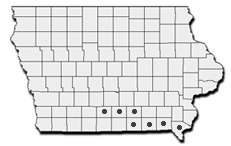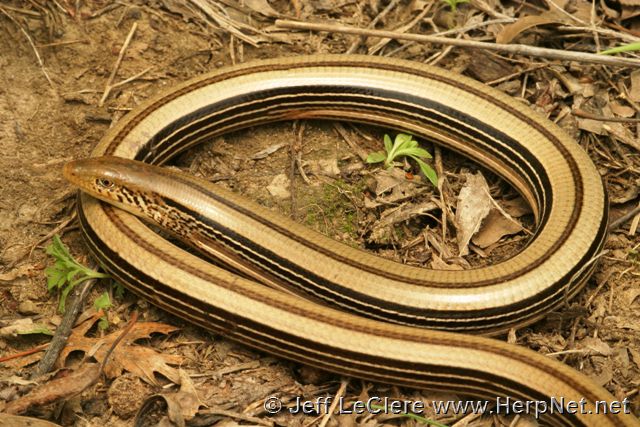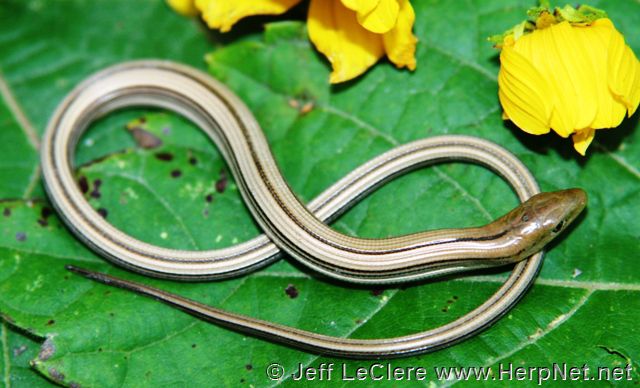Slender Glass Lizard (Ophisaurus attenuatus)
by Jeff LeClere

Status
THREATENED and Species of Greatest Conservation Need. Slender glass lizards are listed as a threatened species in Iowa due to their restricted range and loss of habitat. They were formerly listed as endangered, but several Iowa residents have submitted photos and good locality information which have identified new populations. However, more submissions to us or the DNR are needed!
Description
The slender glass lizard is the most unique lizard found in Iowa. It could be confused with no other lizard, but it may be mistaken for a snake! Glass lizards are Iowa’s longest lizards ranging from 22 to 42 inches long. Glass lizards have no legs at all and are snake-like in body shape, but they have scalation similar to the skinks. They are tan or brown with striping rather similar to prairie skinks. They may have a dark stripe down the back, and alternating black and light stripes on the sides. The belly is white, but the underside of the tail has dark stripes. Only about four to six inches of this lizard is body, the rest is tail.

Glass lizards have movable eyelids, external ear openings, a lateral groove along the side of the body from the neck to the vent, a rigid feel to their body, and the ability to detach their tails – all characteristics snakes lack.
Hatchling glass lizards are vividly marked as described above. Older individuals may lose the markings on the sides, and the stripe on the back may break up into spots or crossbands.
Subspecies
The subspecies found in Iowa is the western slender glass lizard, Ophisaurus attenuatus attenuatus.
Range
The range of the slender glass lizard in not well known in Iowa. Its habits and relative abundance at any particular site make it difficult to define the range and estimate population size. Generally, this lizard is found in southeastern Iowa, from the southeast corner west to south central Iowa. Any sightings should be reported and are greatly appreciated.

Habitat
Glass lizards live in open, grassy areas, dry, rocky hillsides, open forest, oak savanna, and prairies. Though apparently absent from sand prairie habitats in Iowa, it is a favored habitat in other states within its range.
Habits
Glass lizards are active from April to October. They are diurnal; actively foraging during the day even in hot weather (Collins, 1993; Vogt, 1981). They are rarely active at dusk or at night. Unlike our other lizards, glass lizards do not dig their own burrows, although they may burrow if the soil is very loose. They use mammal burrows for refuge and overwintering sites. If approached, they may sit motionless blending in perfectly with their surroundings.

A friend of mine found one much by chance in Kansas, As he was taking a break in the ditch after searching a road cut, he just stood, staring at the ground allowing his vision to go in and out of focus. All of a sudden, he focused and realized he was looking right at a glass lizard. The lizard did not move so as to catch his eye, but was frozen. The second he went for the dive, it was gone. This is another defense of glass lizards, they are fast! They move in a serpentine motion much like snakes, and when in motion, they are tough to catch.
If you do make contact, it will most likely be with the tail. Of course, the tail will detach immediately, sometimes into several wriggling pieces while the body scoots off to safety. They will regenerate a new tail, but it will not be as long, or look as good as the original. It is rather uncommon to find an adult glass lizard that has never broken some part of its tail. The tail is very fragile and does not have to be touching anything to drop off. There is no truth to the belief that the original tail will reattach itself to the body.
Glass lizards are quite uncommon in Iowa. Even though a specimen is found in an area, return visits to that area may not turn up any more specimens at all. There is a lot of suitable habitat where populations may occur but have not been documented. Sometimes, in an attempt to cross roads, they are hit by automobiles. Roadkills though unfortunate, are valuable specimens. Save it and contact the DNR or us if one is found. Glass lizards are suffering from decline due to habitat destruction (flat, open prairie areas are first to be developed), pesticides, and forest encroachment. Open prairies and savanna habitat must be conserved for glass lizards to persist in Iowa.

Breeding occurs in spring. The male bites and grasps the skin of the female’s neck during copulation. They are oviparous laying from 5 to 17 eggs (Collins, 1993) in June or July under forms of cover such as rocks, logs or boards. Females guard the eggs. The eggs hatch in August.
Food
All five species of Iowa’s lizards eat small invertebrates such as crickets, grasshoppers, beetles, spiders, caterpillars, which they chase down and eat. They mash their food up with their strong jaws before swallowing their prey. Glass lizards are able to eat larger foods because they attain larger sizes than our other lizards. Small snakes, lizards, eggs, rodents, and other prey is consumed in addition to insects. Pesticides take a toll on glass lizards because of their insectivorous diet.